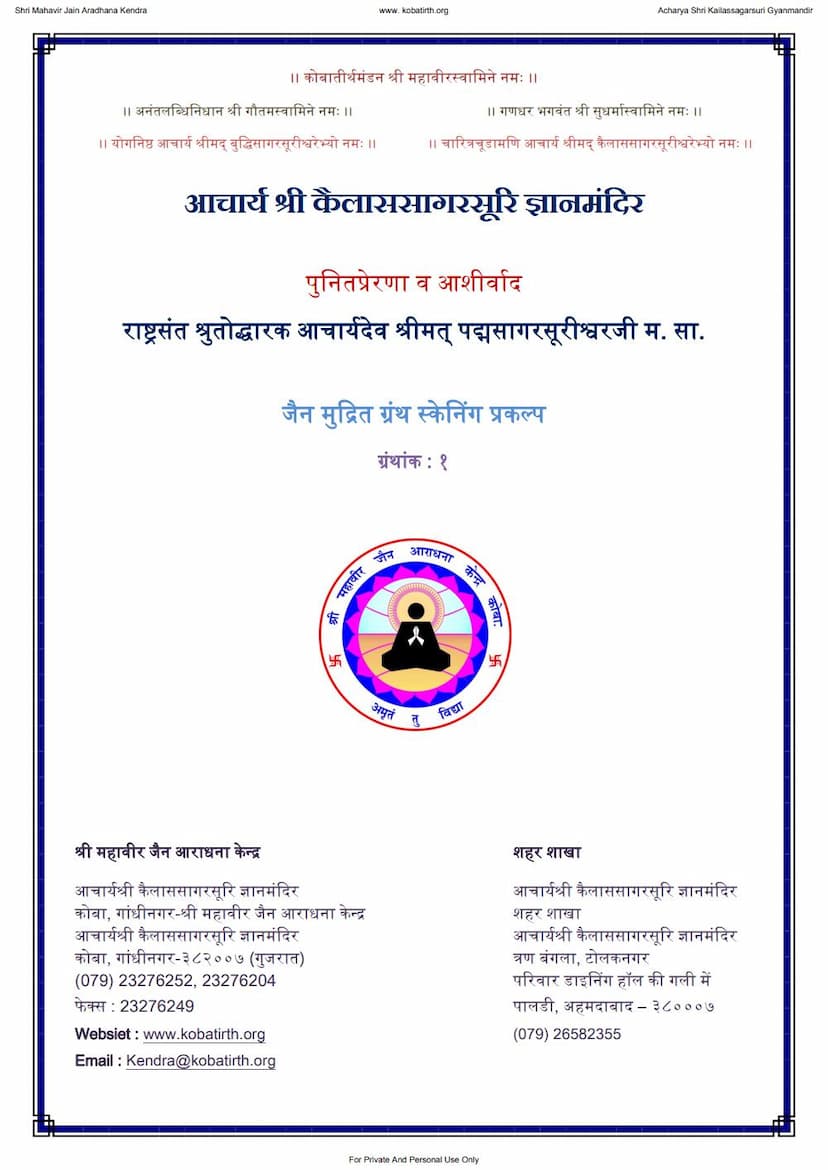Uttaradhyayan Sutra
Added to library: September 2, 2025

Summary
Here's a comprehensive summary of the provided Jain text, Uttaradhyayan Sutra, based on the excerpt:
Book Title: Uttaradhyayan Sutra Author(s): Sudharmaswami, Lakshmivallabh Gani Publisher: Shravak Hiralal Hansraj
Overall Theme: The Uttaradhyayan Sutra, a significant Jain text attributed to Sudharmaswami and commented upon by Lakshmivallabh Gani, serves as a guide for ascetics (monks) and laypeople (shravaks) on the path to spiritual liberation. The provided excerpt focuses on the importance of vinaya (humility/discipline) and then delves into the twenty-two types of parīṣaha (hardships or austerities) that a monk must endure with equanimity and determination to achieve spiritual progress.
Key Sections and Concepts:
-
The Paramountcy of Vinaya (Humility/Discipline):
- The text immediately emphasizes the foundational role of vinaya in the Jain faith.
- A vinīta (disciplined person) is defined by their obedience to religious precepts and their ability to understand and follow the teachings of their gurus. This includes:
- Following commands and instructions (ājnā).
- Being attentive to the guru's guidance and teachings.
- Understanding the guru's intentions and unspoken cues (iṅgita and ākāra).
- Conversely, an avinīta (undisciplined person) disobeys commands, finds faults, and is generally rebellious.
- The text uses vivid analogies and stories (like the kūlavālaka or "riverbank boy" story) to illustrate the consequences of lacking vinaya and the rewards of cultivating it. The kūlavālaka story highlights how disrespect towards a guru led to a downfall, even in the midst of spiritual practice.
-
Enduring the Twenty-Two Pariṣaha (Hardships/Austerities):
- After establishing the importance of discipline, the text shifts to the practical aspects of ascetic life, specifically the twenty-two pariṣaha that a monk must face and overcome. These are presented as essential tests for spiritual growth.
- The text explains that enduring these hardships is not about mere physical suffering but about developing inner strength, detachment, and equanimity.
- Specific Pariṣaha Mentioned and Illustrated: The excerpt details several of these hardships with explanations and illustrative stories:
- Hunger (kṣudhā): The need to endure hunger without resorting to unethical means to obtain food, understanding the nature of madhu-karavr̥tti (like a bee collecting nectar).
- Thirst (pipāsā): The importance of enduring thirst and seeking pure water, not yielding to the temptation of impure sources. The story of dhananmitra illustrates the meticulousness required.
- Cold (śīta): The need to remain steadfast in meditation and spiritual practice even when facing extreme cold, without seeking artificial warmth.
- Heat (uṣṇa): The endurance required during hot seasons, similar to the story of arahaṁnaka.
- Bites of Insects (daṅśamaśaka): The practice of remaining immobile and detached even when insects bite, as exemplified by śramaṇabhadra.
- Lack of Clothing (acelia): The acceptance of nudity or worn-out clothes as part of detachment, and the equanimity needed when clothing is lost or obtained. The story of āryarakṣita is used here.
- Discomfort (ar lit): The ability to remain composed and undisturbed by unpleasant circumstances or feelings.
- Insolence/Abuse (ākrośa): The importance of remaining calm and not retaliating when insulted or abused, as illustrated by the story of the garland maker (mālikā).
- Affliction by Others (va]dha): The need to endure physical harm without anger or hatred.
- Theft (steya): Enduring the loss of possessions without complaint.
- Rejection/Non-acceptance (alābha): The practice of remaining calm when alms are not received or are insufficient, as shown by the example of dhaṁḍhaṇa.
- Illness (roga): The need to face sickness with equanimity and not become attached to cures or repulsed by the condition.
- Pain/Discomfort (sparśa): Enduring physical discomfort from elements like grass, stones, or thorns.
- Other Hardships: The text lists many more, including those related to hunger, thirst, cold, heat, insect bites, nakedness, begging, non-acceptance, illness, suffering, asceticism, doubt, religious decline, insult, personal uncleanliness, inability to get alms, and the difficulty of finding the right path.
-
The Illusory Nature of Worldly Attachments:
- The text repeatedly stresses that worldly possessions, relationships (parents, spouse, children, friends), and pleasures are transient and ultimately unable to provide lasting solace or protection.
- These attachments are described as illusions or sources of suffering that bind the soul to the cycle of birth and death (saṃsāra).
-
The Path to Liberation (Moksha):
- The ultimate goal is moksha (liberation), which is achieved through rigorous adherence to Jain principles, particularly anana (austerity), tapaḥ (penance), and samyama (self-control), all underpinned by vinaya.
- The stories and teachings serve to guide individuals away from attachment and towards detachment, thereby facilitating the attainment of the highest spiritual states.
Structure and Tone:
- The text is structured with verses (sūtras) and detailed commentaries (ṭīkā).
- The tone is instructive, persuasive, and often uses illustrative stories and analogies to convey its message.
- The emphasis on discipline, endurance, and detachment highlights the demanding nature of the spiritual path in Jainism.
In essence, the Uttaradhyayan Sutra, as presented in this excerpt, is a profound spiritual manual that guides its readers to understand the impermanence of worldly existence, the true nature of suffering, and the arduous yet ultimately rewarding path of self-discipline, hardship endurance, and detachment leading to liberation.